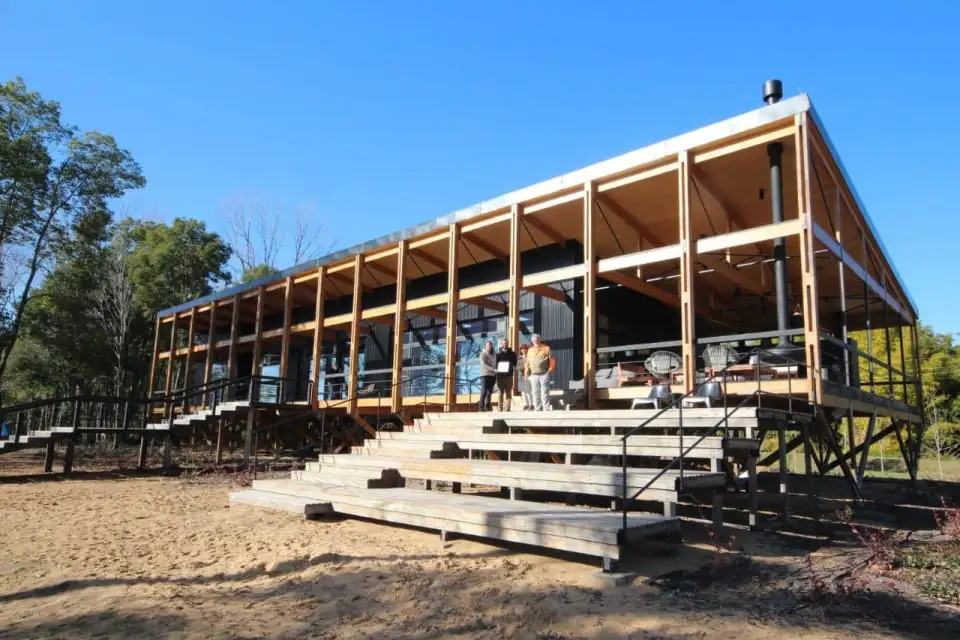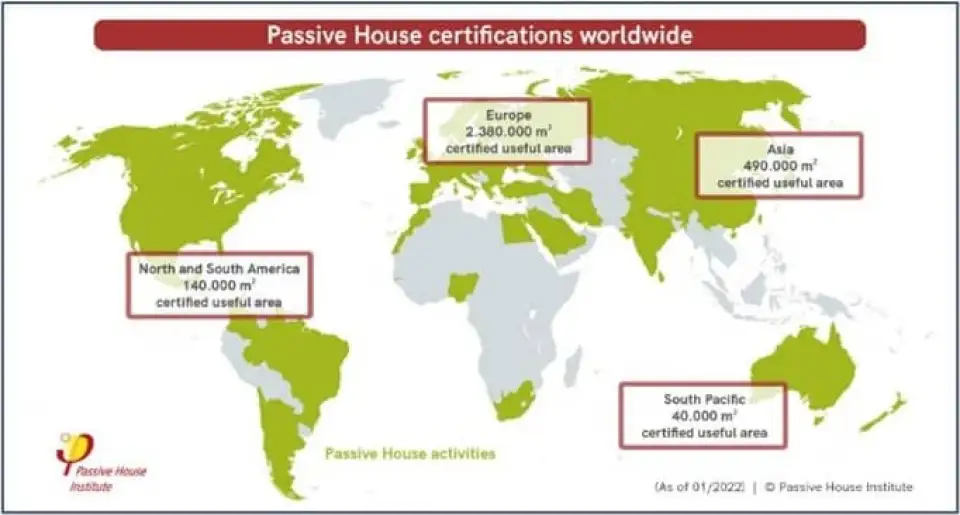
Darmstadt/Munich/Buenos Aires - Climate-friendly buildings are becoming increasingly popular: a higher energy efficient standard means lower energy consumption, resulting in lower energy costs and less carbon emissions. The Passive House Institute has registered a worldwide increase in projects. Certification is voluntary but plays a central role in quality assurance. The research institute in Darmstadt recently awarded Passive House certificates to four special projects: two multi-family complexes in Munich, Germany, and the first two Passive House buildings to be certified in Argentina.
1st Certificate: Communal Space on Offer
Sustainability and community are important to the approximately ninety residents of the StadtNatur (translated “CityNature”) building community: StadtNatur has built thirty-four condominiums in Munich to the Passive House standard. In addition, there are three rentable flats and an office. The garden offers enough space for leisure activities and growing fruits and vegetables. Three feathered friends also roam through the greenery, attended to by the “working group chicken”. Cooking together, yoga, singing and TV evenings regularly occur in the cozy common rooms. The sauna and swimming pond are also very popular with young and old.


More Than Just a Place to Live
The joint building venture StadtNatur built its multi-family housing complex on wasteland near the edge of a forest in Munich. The group wanted the building to provide not only highly energy efficient and comfortable homes, but also a place for community. The infrastructure for communal activities was planned right from the start. Seventy-five meetings were held during the construction phase alone, which fell in the middle of the pandemic.
Michael Konitzer, one of the four executives of StadtNatur, said, "We have really grown together into a great community. Even the people who were skeptical at first are now enjoying the joint activities that are on offer here."
Insulation! Old banknotes!
The photovoltaic system on the roof is operated by StadtNatur itself. The residents established a civil law partnership for this. The public utility company of the city of Munich initially had to be convinced of the feasibility of this model, explains Konitzer. Now everyone in the building benefits from the low internal price for electricity. In addition, there are eleven wall boxes installed for charging electric cars. One hundred sixty bicycle stands are also available. The insulation for this wood hybrid system Passive House building consists of cellulose: old shredded Czech banknotes. Heat and moisture recovery takes place via the ventilation system. The housing community is currently discussing how the energy efficiency of the heat pump can be improved. The residents invite anyone to visit the building during the Passive House Open Days from 11 to 13 November 2022.
2nd Certificate: Passive House District
The entire Prinz-Eugen-Park in Munich was formerly a plot for military barracks and comprises around thirty hectares. Around 1,800 homes have been built here, six hundred of which are part of an ecological model housing development. The now-certified Passive House district is part of this. The roofs of these buildings are designed as roof gardens. A large proportion of rain-water seeps away and evaporates in the root zone of plants. High evaporation helps to alleviate summer heat in the residential environment. There is plenty of space for urban gardening in the neighborhood.

All stakeholders agreed that the handover of the certificate should take place on the communal roof terrace of the Passive House district in Munich's Prinz-Eugen-Park. The residents of this ecological estate regularly come together here and in the adjacent common room. Thirty-six highly energy efficient housing units in eight buildings have been built here as timber constructions. An underground garage and ancillary facilities also belong to this complex, including a communal kitchen.

3rd Certificate: Argentina Is Now Included
It all started when the Heidenreich family visited a Passive House building in neighboring Chile. They quickly realized that their planned house in the Tigre Delta, about 30 km north of the capital Buenos Aires, should also be a highly energy efficient building. According to Erica Heidenreich, the family chose wood as the building material as it is easily obtained and fits in well with the surroundings. The roof is designed so that the sun does not shine on the walls in summer. Inside the house it is pleasantly quiet due to the triple glazed windows. "Of course, that's even more worthwhile in a city than here in natural surroundings, but we enjoy the silence here, too, especially when sleeping," says Erica Heidenreich.


No Longer Subsidized
German-born Erica Heidenreich explains that energy use in Argentina is subsidized. "We were sure that it wouldn't stay like that. And indeed, changes have recently been announced. We are assuming that there will be greater interest in highly energy efficient houses in Argentina in the coming years," says Heidenreich.
This and the other certificate in Argentina were presented by Susanne Theumer from the Passive House Institute. The research assistant is currently travelling with her family by bicycle in South America. "Thanks to the good work of experts from the Latin American Passivhaus Institute, a milestone has been reached here: the first two certified Passive Houses in Argentina. And more projects are on the way," Theumer says happily.
4th Certificate: Argentina Again
Paolo Massacesi's family business manufactures windows. As a certified Passive House Designer and director of the Latin American Passivhaus Institute (ILAPH), Massacesi is familiar with the concept of high energy efficiency. For this reason, his own newly-built house in Mar del Plata, around 400 km from Buenos Aires, was also designed as a Passive House building. "In Argentina, it is still a groundbreaking project to build a highly energy efficient building. We accepted this challenge. Now, among other benefits, we are enjoying a high level of living comfort with fresh air and uniform temperatures," says Massacesi. Visitors also praise the excellent indoor climate.

Self-Produced Windows
The dedicated homeowner implemented the project together with his father and sister. They named their new home "La Dianita" in memory of his mother, says Massacesi. For the outside of the building exposed concrete and stone have been used, the insulation consisting of cellulose is 18 cm thick. The windows were produced by his own company and are triple-glazed. "With this project, we are contributing towards climate-friendly construction and promoting the Passive House standard in Argentina," says Massacesi.


More Certifications Worldwide
The Passive House Institute has registered a significant increase in the total number of certifications: So far, more than 3.3 million square meters of floor space have been certified to the standards Passive House and EnerPHit. The EnerPHit standard is the highly energy efficient standard for retrofits. Quality assurance in the form of a certificate ensures that the requirements for the standards Passive House and EnerPHit have actually been met. Residents can then benefit from low energy consumption and a high level of living comfort.


Europe Ranks Number One
Much is happening in South America with regarding high energy efficiency in buildings. "Of course we are pleased that we can now add Argentina to our world map of Passive House activities," explains Corinna Geiger of the Passive House Institute, who is in charge of building certification. This world map also shows that most of the certified projects are located in Europe. However, other regions are also gaining ground. All information on the quality assurance of buildings as well as the building certification guide are published on the website of the Passive House Institute.
Cover image is of the Passive House district in Munich's Prinz-Eugen-Park and courtesy of Passive House Institute.